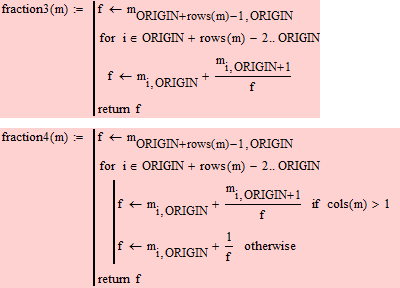Community Tip - You can subscribe to a forum, label or individual post and receive email notifications when someone posts a new topic or reply. Learn more! X
- Subscribe to RSS Feed
- Mark Topic as New
- Mark Topic as Read
- Float this Topic for Current User
- Bookmark
- Subscribe
- Mute
- Printer Friendly Page
Converting Notation for Continued Fraction to single Fraction.
- Mark as New
- Bookmark
- Subscribe
- Mute
- Subscribe to RSS Feed
- Permalink
- Notify Moderator
Converting Notation for Continued Fraction to single Fraction.
- Labels:
-
Other
Accepted Solutions
- Mark as New
- Bookmark
- Subscribe
- Mute
- Subscribe to RSS Feed
- Permalink
- Notify Moderator
OK, here you are:

fraction3 was the first attempt and only works with two column matrices while fraction4 should work with both.
Again no errorhandling - use at your own risk 😉
See attached worksheet.
WR
- Mark as New
- Bookmark
- Subscribe
- Mute
- Subscribe to RSS Feed
- Permalink
- Notify Moderator
fraction is sort of a modifier for confrac and I don't think that there is a built in function which does what you want. But it's not hard to write your own - see attached file.
WR

- Mark as New
- Bookmark
- Subscribe
- Mute
- Subscribe to RSS Feed
- Permalink
- Notify Moderator
Many thanks for the following function, Winfrod.
Regards,
-LL-
- Mark as New
- Bookmark
- Subscribe
- Mute
- Subscribe to RSS Feed
- Permalink
- Notify Moderator
If you don't mind, could I go beyond my question a bit, Winfrod :
Best Regards,
-LL-
- Mark as New
- Bookmark
- Subscribe
- Mute
- Subscribe to RSS Feed
- Permalink
- Notify Moderator
Loi Le schrieb:
If you don't mind, could I go beyond my question a bit, Winfrod :
Not sure what you really need. Does the problem you are working on involve continued fractions of numbers or of functions? As you have determined yourself my fraction2 only works with a single column vector as is the result if you apply confrac to a number. Its a quick hack and furthermore has no error handling whatsoever. So e.g. the last number in the vector must no be zero or the product of the last two numbers in the vector should not equal to -1.
My fraction2 does not work with those two column matrices as are created when you apply confrac to a function or confrac,matrix to a number.
What did you expected to get by applying funtion2 to the result of e(x) confrac? You sure can not excpect to get the function e(x) but rather a rational function approximating e(x) to some degree.
If you need a function dealing with those two column matrices the function has to be rewritten.
Let me know what you need.
WR
- Mark as New
- Bookmark
- Subscribe
- Mute
- Subscribe to RSS Feed
- Permalink
- Notify Moderator
Hello again,
My original question was answered. I have a related question:
Best Regards,
Loi Le.
- Mark as New
- Bookmark
- Subscribe
- Mute
- Subscribe to RSS Feed
- Permalink
- Notify Moderator
OK, here you are:

fraction3 was the first attempt and only works with two column matrices while fraction4 should work with both.
Again no errorhandling - use at your own risk 😉
See attached worksheet.
WR
- Mark as New
- Bookmark
- Subscribe
- Mute
- Subscribe to RSS Feed
- Permalink
- Notify Moderator
I greatly appreciate your help, Winfrod :
Regards,
-LL-





